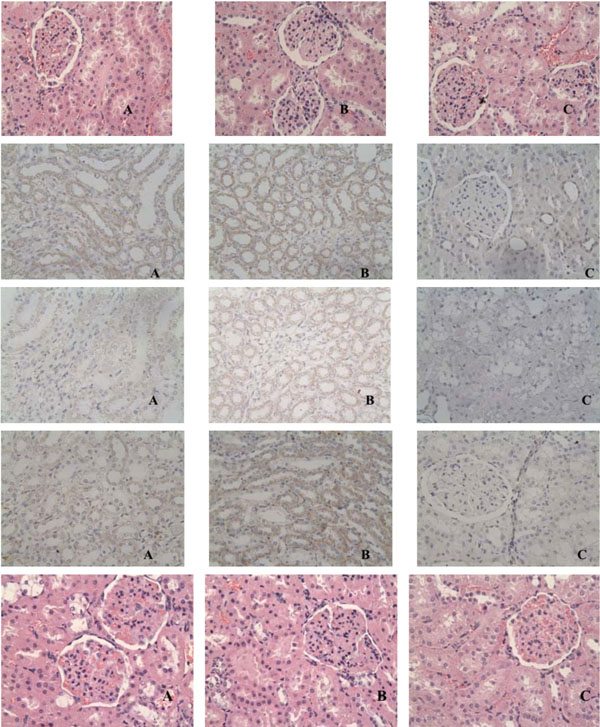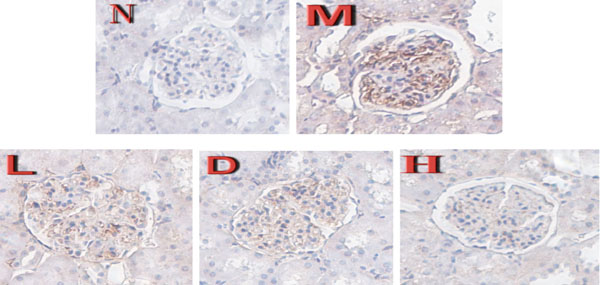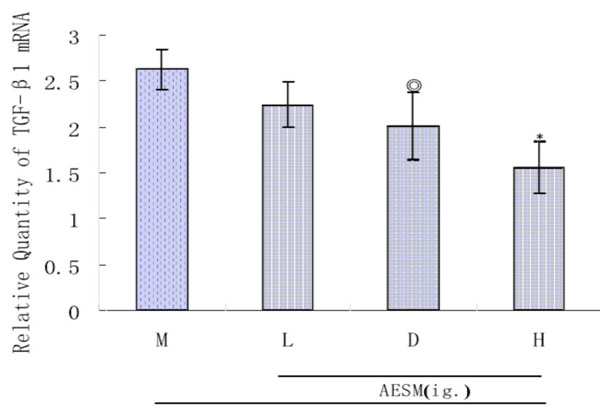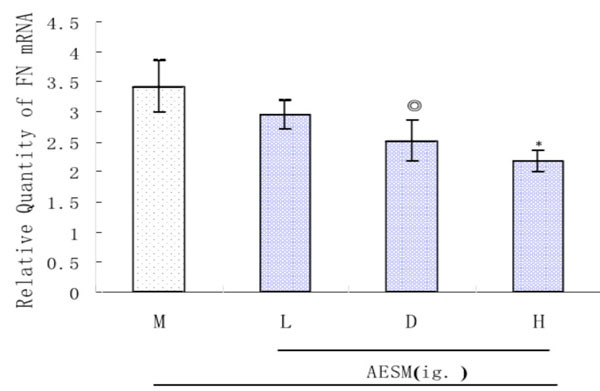All published articles of this journal are available on ScienceDirect.
The Influence of Corn Silk Polysaccharide on Signal Pathway of TGF-β1 in Type 2 Diabetic Mellitus Rat
Abstract
The study performed some experiments and made following conclusions. In the prevention stage, comparing with normal control group, triglycerides, blood sugar (BG), 24-hour urinary protein and cholesterol (CHO) were higher in T2DM group, but weight and urea nitrogen (BUN) was less in that group. 24-hour urinary protein and cholesterol (CHO) were higher in T2DM group than the intervention group. 24-hour urinary protein and BG in the intervention group were also observed to be higher than the normal control group, but BUN was less than the normal control group. In the intervention group, the weight of kidney and the weight of rat were also higher than T2DM group, but CHO and 24-hour urinary protein were less than T2DM group. The expression of TGF-β1 in T2DM group was also observed to be more than the other groups. However, in the treatment stage, serum creatinine (Cr), weight, BG and CHO, TGand 24-hour urinary protein were significantly higher in the DN rats than those in the normal control rats (P>0.05). The expression level of TGF-β1 and triglyceride level in the corn silk dihydroxycorn silk3 treated group were noticeably lower than those in the DN rats.
1. INTRODUCTION
This research project is associated with the key project of “Agricultural Science and Technology Department” of Jilin Province based on “comprehensive development and utilization of resources of corn filament key technology”. Corn silk has been used as a medicine since ancient times, with various functional activities, such as lowering blood glucose, reducing blood lipid, lowering blood pressure, immune regulation, anti-tumor, antipyretic choleretic, hepatoprotective and antioxidant effects. [1] Firstly on corn smut, polysaccharide determination methods were employed, which are most suitable for screening polysaccharides yield. Following this, polysaccharide extraction process was systematically analyzed on maize. The comparative analysis of the decocting method was made, using high and new technology in the microwave method and high pressure pulsed electric fields effects on the yield of polysaccharides, by response surface analysis and optimization of the optimum conditions of the extraction process. The prepared corn smut polysaccharide was used to study the hypoglycemic activity of mice and to investigate the effect of polysaccharides on blood glucose, blood lipid and total cholesterol levels. In addition, the corn silk polysaccharide was analyzed to test the nerve excitability of two commercially available drugs on double-muscle of hyperglycemia mice and resistance to fatigue effects. [2] Finally, the composition of the polysaccharide was determined by gas chromatography, and the secondary structure was predicted by IR spectrum.
2. OBJECTIVE
The active polysaccharide in nature mostly have the structure of carbohydrate, but also exists in the form showing a combination of the covalent bond and lipid, skin or protein, etc. The active polysaccharide is usually a complex of covalent bond and lipid, skin or protein bound state. Thus, the yield of active polysaccharides can be expressed as the rate of crude polysaccharide, and the yield of crude polysaccharide in samples determines the quality of the sample. Li Bo et al. in their study found that the neutral sugar yield of corn was 41.33%, which was mainly composed of glucose, galactose, Arabia sugar, galactose acid, mannose and xylose. This chapter determined corn silk polysaccharide by 3, 5 12 nitro salicylic acid colorimetric method and enthrone color method and phenol sulfuric acid method, respectively, and compared them, in order to choose a fast and accurate method for the determination, recovery rate and precision analysis on the determination results. [3] Polysaccharides are usually found in D glucose, D half lactose, L - arabinose, l in Li sugar polymerization. Because, the sugars with strong inorganic acid are endemic to the dehydration reaction and generate aldehydes, they, with a variety of phenolic condensations, are used to produce unique colored substances and in the visible light region show different maximum absorption peaks. Therefore, experiments were conducted to investigate three methods; phenol sulfuric acid method and anthrone sulfuric acid method and DNS determination of water provided alcohol precipitation of polysaccharides yield, and the detecting methods were further compared and analyzed. This experiment selected a glucose standard curve for showing the production standard. (Fig. 1) Respectively absorb 0, 0.2, 0.4, 0.6, 0.8, 1.0, 1.2m1 glucose standards, with deionized water supplement volume to 2ml, were at 490 nm, anthrone sulfuric acid method in 63 nm absorbance values were measured by phenol sulfuric acid method, respectively, other preparation concentration for LM left ml glucose standard solution, by the DNS method at 540 nm absorbance values were measured.

The influence of corn silk polysaccharide on TGF-β1 in type 2 diabetic mellitus rat.
Repeating 5 times, the precision absorb glucose standard solution (2ml), was added to the phenol sulfuric acid, anthrone sulfuric acid, 3, and 5 dinitro salicylic acid, which was shaken, after being heated in boiling water bath for 15 min, and then cooled down to room temperature. The maximum absorption wavelength was measured to determine the absorbance values. Furthermore, relative standard deviation values were obtained to investigate the precision of the 3 methods.
3. STATISTICAL ANALYSIS
Reproducibility refers to the precision of the results measured by different researchers in different laboratories. Varieties of corn smut samples of 0.05g (5) were taken from the same source. According to the tested sample solution of preparation method, parallel samples were prepared for testing the solution of 5, each of 2ml with maximum absorption wavelength parallel to the determination of the absorbance value. [4, 5].
Because the total sugars in plants include sugar, oligosaccharides and polysaccharides, which are reducing sugars, but no reduction was observed in oligo - and polysaccharides. High concentration acid is required under the condition of heating hydrolysis for measuring reducing monosaccharides, therefore, the investigation of reducing sugar in corn silk yield obtained from different origins is vital.’ The three areas of the sky view, Siping, Nong'an produced by corn must nutrition ingredient analysis shows that day scene area corn must nutrition in the reducing sugar yield was much lower than that of Siping, Nongan area. Corn in Siping Nongan area contained reducing sugar yield with a difference of less than 0.5%, however, the difference was not significant.
3.1. Test
- Corn silk found in the three regions in Siping, Nong'an with nutritive components, including ash, moisture, protein, fat, reducing sugar content difference, provides support data for corn in Jilin Province suggesting that corn in three areas is widely developed.
- Comparative analysis of the yield of polysaccharides in food widely used at home and abroad was determined, and the effects of the three methods for the determination of precision, stability and reproducibility and recovery rate of contrast were assessed. The polysaccharide material for subsequent decrease in hypoglycemic activity provided a reliable, accurate and high stability yield determination method.
- The phenol sulfuric acid method, anthrone sulfuric acid method and DNS method were used for corn silk polysaccharide yield determination and these methods were compared in terms of accuracy and diversity, for the determination of polysaccharide yield evidence. Reference [6] presented that the temperature of extraction of corn silk polysaccharide yield effect was 20.0C which was increased to 100.0C, and polysaccharide yield increased from 1.0% to 2.3. The yield initially increased slowly which continued to increase at 60.0C, which is the suitable temperature for extracting factors, as high temperature may bring damage to the structure of the cell wall , the intracellular water soluble polysaccharide, a large number of dissolution [7]. The structure of polysaccharide based material is susceptible to degradation in high temperature, therefore, the leaching temperature of 90.0C is not suitable for the experiment. With the extension of time, the rate of polysaccharide increased gradually. From the aspects of production cycle, energy consumption and the yield of polysaccharide, the extraction time was 50min.
3.2. Results
Actively assayed; Immunohistocmical study was adopted to analyze the expression of TGF-R line renal tissue. Moreover, Real-time RT-PCR technology was used to analyze the expression of TGF-R 1 and FN in renal tissue. Comparing results of the model control group, AESM of middle and high dose with remarkably lower level of FBG, kidney index and Ualb (PGO. 05 or PGO. O1), dominantly decreased the expression of TGF-R 1 and FN in renal tissue (PGO. 05 or PGO. O1). It was concluded that AESM can lower the level of FBG, kidney index and Ualb in diabetic rats, down regulate the expression of TGF-R 1 and FN in renal tissue, and regulate the synthesis and degradation of extra cellular matrix. Thus, AESM can alleviate renal pathological lesion, and has a renoprotective effect on diabetic rats (Fig. 2).

The glomeration of rats in each group of TGF-β1 Immunohisto chemistry pictures.
4. INFLUENCE
For investigating the effect of aqueous extract from stigma maydays (AESM) on the expression of transforming growth factor and fibronectin(FN)in renal lesion of type 2 diabetic rats, approaching its effect-dive mechanism, type 2 diabetic rats model was induced with high-sugar and high-fat dietary feeds and low dose streptozotocin(STZ). Rats were randomly divided into five groups; Normal control group, Model control group, AESM low, middle and high dose group. After treatment of 8 weeks, the level of fasting blood glucose (FBG), kidney weight and urinary albumin (Alb) were obtained (Fig. 3).
Objective: By using three different methods; semi-bionic, water extraction and ethanol extraction and comparing these extraction methods, extraction technology of corn-silk total spooning was researched, to provide a basis of industrialization and technology for corn-silk total spooning.
- Total spooning extract process for comparison of stigma Maydays using Ultraviolet-visible spectrophotometer was used to determine the content of total spooning in Stigma Maydays. This paper studied the effect of single factor such as acid extraction time, base extraction time, ultrasonic power, and liquid solid ratio to the extraction rate of total spooning. Experiment method was used to optimize the process parameter of semi-bionic; water extraction and ethanol extraction, and extraction ratio of total spooning using these methods was compared.
- Purification process of total spooning extract using macro porous adsorbing resin D101 was used in Stigma Maydays which purified total spooning by ethanol extraction. The paper also discussed purification in terms of extract concentration, flow velocity, ethanol fluent in different concentration, etc.
- Diabetic complication prevention of Stigma Maydays cumming male mice (Certificate of Conformity: SCXK (hubris) 2008-0003), weighing 18一22g were provided by the Wuhan Institute of Biological Products. 50 mice were treated with Streptozotocin 200mg/kg by intraperitoneal injection after overnight fasting of 12h. Fasting blood-glucose was detected 3 days later 20mmo1/L. Model mice were randomly divided into 3 groups. Positive control mice were treated with rosiglitazone 1mg/kg by oral gavages. Experimental group mice were treated with total spooning extract of Stigma Maydays 400mg/kg by oral gavages, and high fat diet for daily diet. Wild type mice were treated with ordinary diet. (Fig. 4).

Type 2 diabetic rats (STZ injection).

Type 2 diabetic rats (STZ injection).
In the optimum condition of the corn silk polysaccharide material, the pilot production line was used to expand the production, and enhance the purification of the polysaccharide yield. Since, protein and polysaccharide were insoluble in ethanol, therefore, in the alcohol precipitation process, corn silk protein and polysaccharide together were isolated. and plants polysaccharide and protein, nucleic acid binding, formation of glycoproteins, substance, so experimental comparative analysis the sewage method and trichloroacetic acid (TCA) removal of corn to be polysaccharide protein material removal rate of protein and polysaccharide loss rate. While using reverse micelle method of corn for crude polysaccharide decolorization treatment for the removal of corn silk polysaccharide from the solution of small molecular substances, differences in decolorization rate and polysaccharide loss rate were compared to obtain the corn most suitable for polysaccharides extraction . The molecular weight was determined by gel chromatography and structural identification of the compounds with the activity of reducing glucose was carried out.
The results of the gas chromatography of the polysaccharide hydrolysate of maize are shown in Fig. (2), and the type of the sugar was determined according to the retention time of the standard sample. Monosaccharide known standard glucose retention time of 13.567 min, galactose 12.288 min, rat Li Tangwei 7.254 min, xylose 8.823min, arabinose 7.070 min, fructose 9.314 min mannose as 10.560 min. Corn silk measured in crude polysaccharide of monosaccharide groups was divided into mannose, galactose (Gal), xylose (xyl), arabinose (ARA) and fructose (FRU and retention times were 10.557min, 12.281min, 8.819min, 7.095min and 9.551min, respectively. The content of xylose was relatively high which was 0.96:0.75:1.84:1:0.71.
- The optimized extraction process of Semi-bionic was AZBZCZD3, including acid (pH=2.5) with extraction time of 90 min, base (pH=7.5) extraction time of 90min, ultrasonic power of 70W, and solid liquid ratio of 1:40.The effects of factors were in the order of A acid extraction time >D solid liquid ratio>C ultrasonic power>base extraction time. The extraction rate of total spooning was 0.676%. The optimized condition of water extract was A3CZB2, with extraction time of 120min, ultrasonic power of 70W, solid liquid ratio of 1:30, and the effects of factors were in the order of A >C> B. The extraction rate of total spooning was 0.329%. The optimized condition of ethanol extract was A1C3B3D3, ethanol concentration was 60%, extraction time was120min, ultrasonic power was 90W, solid liquid ratio was 1:40, and the effects of factors were in the order of D >C>A>B, The extraction rate of total saponin was 0. 564%. The extraction rate of total spooning of Semi-bionic was the highest. The reason was likely the acid-base interaction leading Stigma Maydays Cell wall rupture, which resulted in a extensive active component dissolving.
- Optimized condition of Macro porous adsorbing resin D101 included sample volume of 20m1, flow rate of 2ml/min, sample concentration of 44.96mg/ml, and optimized fluent concentration of 70% ethanol. The extraction of total spooning in this condition was 36.91mg/ml, and this process was stable and efficient.
- The average value of blood glucose in model mice was 16.2 mo1 /L. The distinct difference (P<0.O1) between model and wig 1d type indicated modeling successfully. Blood glucose index: In the experimental group (total spooning of Stigma Maydays), and positive group (rosiglitazone) the blood glucose index was distinctively decreased compared with WT group (P<0. O1), indicating that the total spooning of Stigma Maydays had an effect on decreasing diabetic blood glucose’s and TG index. The difference between model and WT indicated streptozotocin diabetes mice initiating lipid metabolic disorder. The difference between experiment group and WT also indicated that total spooning of Stigma Maydays can ameliorate lipid metabolic disorder in streptozotocin diabetes mice. CR and BUN indexes and BUN level in the model and positvie group were distinctively different than that in the wild type, indicating that total spooning of Stigma Maydays can improve renal function of the diabetic mice. Weight, kidney weight, Weight/kidney weight index: The Weight, kidney weight, Weight/ kidney weight of model and WT were observed to be distinctively different, indicating that total spooning of Stigma Maydays has a role in kidney protection by decreasing trinomial. Kidney morphology observation: In WT, glomerular volume was normal, the glomerular capsule was clear. In Mike’s Model glomerular was swollen, and capsule was deformed. Experimental group mice’s glomerular was partly swollen, while glomerular capsule was normal, which indicated that the total spooning of Stigma Maydays exhibited prevention effect on diabetic mice. Conclusion: The paper studied the extraction process of total spooning of Stigma Maydays by using Semi-bionic method and compared it with water extract and ethanol extract. Results indicated that Semi-bionic method was better than water extract and ethanol extract, providing a basis for industrial production of total spooning of Stigma Maydays. Purified total spooning has a prevention effect on lipid metabolic disorder in diabetic mice and diabetic kidney disease.
5. EXPERIMENT
Research on key technology of structural preliminary identification and anti-diabetic effect of polysaccharides from corn silk is associated with the key agriculture program of technology hell in Jillian province (item number: 20080224). The program mainly focuses on five aspects of this research, and the main achievements of the program are illustrated below.
- This paper studied three determination methods of polysaccharides yield by phenol-sulfuric acid, enthrone-sulfuric acid and DNS determination methods. Comparing and analyzing the accuracy and precision between three different methods, the results showed that the regression equation of method one was y=6.8696x +O.O111, R2=0.998, and the equation was linear within the range of 20-140g. The regression equation of method two was y=6.2161x-0.0292, RZ=0.9944 and the equation was also linear within the range of 20-140}g, However, the regression equation of method three was y=1.3921x-0.0339, RZ=0.9926, and the equation was linear within the range of 0.2-1.40mg. In the regression equation, y represents absorbance, and x is the quality of glucose standard.
- It was concluded that phenol-sulfuric acid method for the determination of polysaccharide yield showed good precision and reproducibility. Because the RSD values in precision test, stability test and recovery test were better than the values obtained by other two methods. The RSD values in reproducibility experiment were less than the DNS method. Phenol-sulfuric acid was selected to determine the yield of polysaccharides from corn silk.
- Boiling extraction method We have made the single factor experiment and the L16(45) orthogonal experiment design, and found that the factors affecting the yield of polysaccharides are extraction temperature (0C)> ratio of solid to liquid> time(min)>particle size(mesh)and the optimum parameters of technology of extraction include : extraction temperature 90 0C, ratio of solid to liquid 60:1, time 60min, particle size 80 mesh, the yield of polysaccharide 2.320/0。The extraction temperature has significant effects on the extraction of polysaccharides (a<0.05).
CONCLUSION
Corn silk polysaccharide D3 can inhibit the expression level of TGF-β1 in diabetic rat’s kidney and restrain macrophages in order to protect the kidney of diabetic rats.
CONFLICT OF INTEREST
The authors confirm that this article content has no conflict of interest.
ACKNOWLEDGEMENTS
This work is supported by the Effect of Polysaccharide from Stigma Maydis on TGF-βl/Smad Signal Pathway of Renal Tissue in Type 2 Diabetic Nephropathy Rats (FGG-201334).


